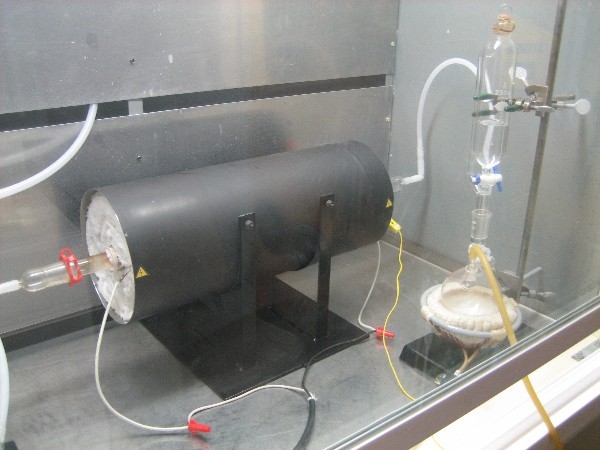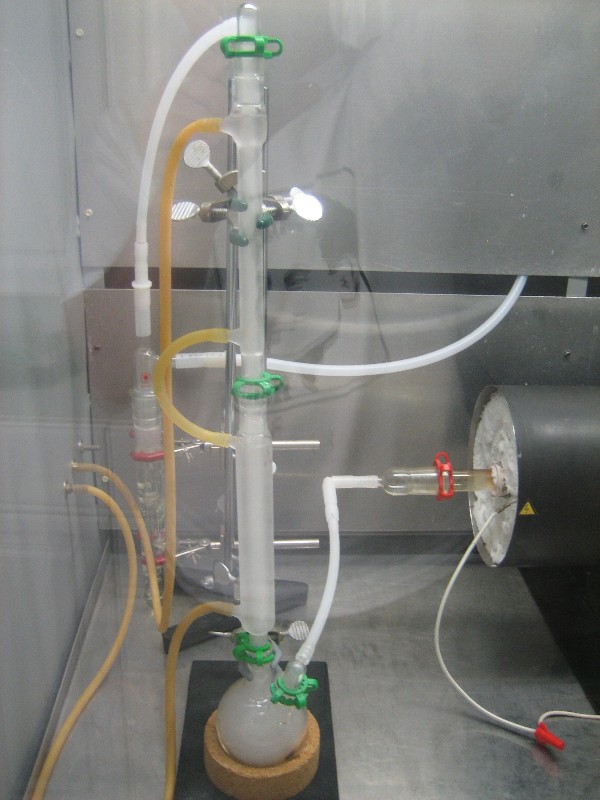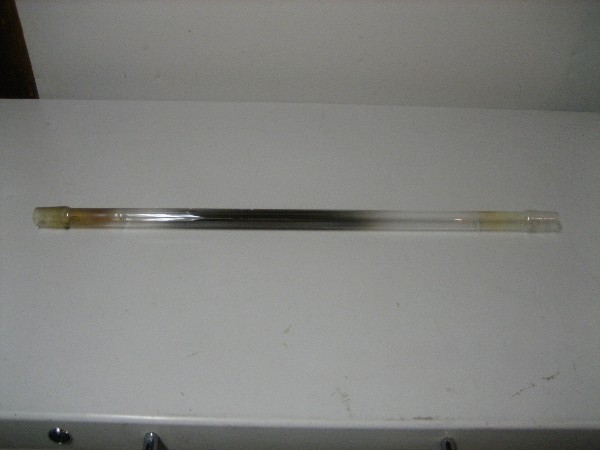| Pages:
1
2
3
4 |
garage chemist
chemical wizard
    
Posts: 1803
Registered: 16-8-2004
Location: Germany
Member Is Offline
Mood: No Mood
|
|
Silica kills Kanthal wire, the manufacturer warns of this in the technical brochure for the heating wire alloys. No material containing significant
amounts of free silica must touch Kanthal wire while in operation, clays and bricks touching the wire must contain at least 45% alumina.
Although I will cover the wire on the tube with an insulation paste, I'd rather not use diatomaceous earth. The connecting ends of the wire would also
be in contact with the silica.
Brauer uses the kind of insulation you're proposing with MgO instead of diatomaceous earth, this would work for my furnace. But I have no cheap source
for MgO, and it would probably cost more than fiber insulation in the end if I buy the MgO from one of the sources known to me.
Still a good idea.
|
|
|
Fleaker
International Hazard
    
Posts: 1252
Registered: 19-6-2005
Member Is Offline
Mood: nucleophilic
|
|
Can't you just simply burn magnesium metal, dissolve in water to hydrolyze any nitride to ammonia, and then heat the resulting magnesium hydroxide to
MgO?
Neither flask nor beaker.
"Kid, you don't even know just what you don't know. "
--The Dark Lord Sauron
|
|
|
not_important
International Hazard
    
Posts: 3873
Registered: 21-7-2006
Member Is Offline
Mood: No Mood
|
|
Glad you've a source of magnesium metal that is cheaper than any of its salts.
Epsom salts and sodium bicarbonate or carbonate give basic magnesium carbonates as a precipitate. Heating these to 400 C will decompose them to the
oxide, provided you have an escape route for the CO2 and H2O.
|
|
|
evil_lurker
National Hazard
   
Posts: 767
Registered: 12-3-2005
Location: United States of Elbonia
Member Is Offline
Mood: On the wagon again.
|
|
I noticed one of the local co-op feed stores had feed grade MgO in 50lbs bags.
I didn't check to see how much it was, but I bet $30 would probably get it.
Not all chemicals are bad. Without chemicals such as hydrogen and oxygen, for example, there would be no way to make water, a vital ingredient in
beer.
|
|
|
garage chemist
chemical wizard
    
Posts: 1803
Registered: 16-8-2004
Location: Germany
Member Is Offline
Mood: No Mood
|
|
I dont have such a source of MgO, but the epsom salts and sodium carbonate (why bicarbonate? the carbonate is way cheaper here) idea would be good to
make the MgO that I need for the insulation paste (a mix of MgO and Al2O3 according to Brauer- I'll probably use Al(OH)3 instead of Al2O3 since I only
have that and I dont think it is necessary to convert it to the oxide prior to mixing with the MgO).
I now decided on using the ceramic fiber- the cutoffs can be used as carrier for vanadium pentoxide catalyst as shown in the SO3 preparation which I
want to attempt too.
Does someone know more about the chemistry of the ceramic fibers? I found a manufacturer datasheet that list 10% ZrO2 in the 1400°C product, and the
1400°C mat contains only 40% alumina while the 1260°C mat contains 46% alumina.
|
|
|
not_important
International Hazard
    
Posts: 3873
Registered: 21-7-2006
Member Is Offline
Mood: No Mood
|
|
Bicarbonate because it is the most likely to be found pure, in some regions there are no OTC sources of sodium carbonate without additives. Also
bicarbonate results in a precipitate closer to MgCO3 than carbonate does, which could be important for some uses although not so in your case.
If you have patience you can wash the precipitate by decantation, you do want to wash it to remove most of the sodium.
|
|
|
Klute
International Hazard
    
Posts: 1378
Registered: 18-10-2006
Location: France
Member Is Offline
Mood: No Mood
|
|
You can find magnesium carbonate and/or oxyde in climbing shops (or specialized sports shops) as a talc the climbers put on their hands. Very cheap, I
used to make MgSO4 with those with H2SO4, the crystals were nice and white and seemed relatively free of major contaminants other than other
carbonates/oxides/chlorides etc. For your use that could be more than enough, check it out. The composition was indicated behind all the products I
stumbled on, apparently some climbers prefer the oxyde, others the carbonate. They have different trivial names.
Thought it could help.
|
|
|
Fashist
Hazard to Self
 
Posts: 73
Registered: 19-7-2007
Member Is Offline
Mood: Powerful
|
|
bravo.bravo
finally you success.
you defeat Darn keten lamp method
really nice picture and Equipment.
What is your idea about copper tube?
after heating it wont melt plastic tube?
MAY YIELD INCREASE ?
THX
[Edited on 29-11-2007 by Fashist]
|
|
|
Fashist
Hazard to Self
 
Posts: 73
Registered: 19-7-2007
Member Is Offline
Mood: Powerful
|
|
No Answer?
|
|
|
garage chemist
chemical wizard
    
Posts: 1803
Registered: 16-8-2004
Location: Germany
Member Is Offline
Mood: No Mood
|
|
I dont know if a copper tube is suitable. Steel and quartz work, pyrex may work as well if it doesnt become too soft.
You can see more pictures of my tube furnace here:
http://www.versuchschemie.de/topic,9256,0,-Bau+eines+Rohrofe...
This tube furnace has broken, and at the moment I dont have a suitable tube furnace so I cant do any more work with hot tubes until I have built the
new tube furnace.
|
|
|
Fashist
Hazard to Self
 
Posts: 73
Registered: 19-7-2007
Member Is Offline
Mood: Powerful
|
|
Thanks Mr Garage Chemist.
Nice Pictures.
You Used What type of Element ?
What Gauge?
What Type(chromel,..)?
How long?
|
|
|
garage chemist
chemical wizard
    
Posts: 1803
Registered: 16-8-2004
Location: Germany
Member Is Offline
Mood: No Mood
|
|
The wire is NiCr 80/20, chromel would be a trade name of it, as well as Nikrothal 80, Nichrome etc...
It has 1mm diameter and such a length (18,89m) that it takes up 2000 Watt at 230 Volt. It is wound into 1,2cm diameter spirals (four of them, each
40cm long).
The furnace is good for up to 1000°C, the wire can take 1200°C surface temperature.
[Edited on 30-11-2007 by garage chemist]
|
|
|
Fashist
Hazard to Self
 
Posts: 73
Registered: 19-7-2007
Member Is Offline
Mood: Powerful
|
|
Mr Garage Chemist Thanks
I Have 3 Question(My Name Should Change to Mr Question)
(?)Do you Have Problem with Carbon Dust inside Your Quartz Tube?
(?)Did you Test your Anhydrid With water?(What is it Purity?)
(?)What is YIELD or Output of Your System(ex. 1lit per 24hour or less)?
Thx
|
|
|
Fleaker
International Hazard
    
Posts: 1252
Registered: 19-6-2005
Member Is Offline
Mood: nucleophilic
|
|
Yield per day is entirely dependent on how much acetone you put through it and how quickly. With a meter long tube furnace with a 7.6cm diameter tube
inside of it, I would guess that one could make 500mL per hour of Ac2O if your system was running at its best.
Neither flask nor beaker.
"Kid, you don't even know just what you don't know. "
--The Dark Lord Sauron
|
|
|
Fashist
Hazard to Self
 
Posts: 73
Registered: 19-7-2007
Member Is Offline
Mood: Powerful
|
|
MR Fleaker This is Necessary to Cover all of Copper Tube with Steel? or just the Tube Inside Heater?
Thanks
|
|
|
Fleaker
International Hazard
    
Posts: 1252
Registered: 19-6-2005
Member Is Offline
Mood: nucleophilic
|
|
You can use copper entirely copper if you want, it will just oxidize on the outside which is exposed to oxygen. We used a stainless steel tube packed
with copper wool, and when we opened it, the copper was just as bright and shiny as when we packed it.
Neither flask nor beaker.
"Kid, you don't even know just what you don't know. "
--The Dark Lord Sauron
|
|
|
Fashist
Hazard to Self
 
Posts: 73
Registered: 19-7-2007
Member Is Offline
Mood: Powerful
|
|
Mr Fleaker you think that My picture and design for making anhydrid is wrong?
Mr not important guide me that my system wont work well.
Wat is your idea?
What ballon and how long tube and.. i should use?
What is your advise for making 5-10lit anhydrid per day?
Really Thanks
|
|
|
Magpie
lab constructor
    
Posts: 5939
Registered: 1-11-2003
Location: USA
Member Is Offline
Mood: Chemistry: the subtle science.
|
|
This post is really about the synthesis of Ac2O via ketene reaction with glacial acetic acid. As there have been two major posts about that already
in this thread I decided to continue here also.
A few days ago I tried my first Ac2O synthesis using my homemade tube furnace. I'm not sure if I made any Ac2O as I haven't fractionated the product
yet. My post here is to ask for your comments on unexpected problems of goo and coke. My equipment configuration is essentially the same as that of
my predecessors, garage chemist and NERV, with some subtle differences.
I purged with argon before and after the run and had no fires, and am happy with that aspect. Neither did I smell any ketene as my hood blower was
doing its job.
I had to abandon my fritted glass gas dispersion tube as it caused excessive flow resistance (back pressure), so just used a straight open tube in the
absorber/reactor column. I fed the furnace with acetone vapor generated on a hot (near boiling) water bath along with some argon. I tried to feed
about 3 ml/min acetone to the furnace but didn't get that high a rate. Recovered acetone was 55%.
The biggest surprise was the appearance of quite a bit (1-2 mL) of a translucent white goo collecting in the inlet adapter of the tube furnace. Also
there was a liquid in the outlet adapter, but off-color due to absorbed gunk (carbonized material). The inside of the quartz tube had a thin film of
coke also. After thinking about these unexpected problems for a while I have come to the following conclusions:
1. The goo collecting in the inlet of the furnace was probably phthlate plasticizer leached from 18" or so of 5/16" ID PVC plastic inlet tubing by
the hot acetone vapor.
2. The coke in the furnace probably was plasticizer degradation products.
3. The liquid in the furnace outlet was more plasticizer, possibly mixed with acetone.
I ripped out all of the PVC tubing and threw it away as it stunk like a BBQ gone wrong.
At first I thought that the silicone grease used on the ground glass fittings was being leached out by the hot acetone. This may be a contributor but
I think it was mostly plasticizer. Next time I will use LDPE tubing.
Comments, suggestions, questions, and criticisms are welcomed.
[Edited on 4-9-2008 by Magpie]
|
|
|
garage chemist
chemical wizard
    
Posts: 1803
Registered: 16-8-2004
Location: Germany
Member Is Offline
Mood: No Mood
|
|
I did not have any goo or coke deposit in the tube.
I only saw a minuscule amount of dark oily droplets in the tube after the experiment, no coke.
What was the temperature you worked at? Too high a temperature could certainly lead to carbonization. If you stayed at 700°C, perhaps try 650°C if
the carbonization problem persists even after you changed the plastic parts to something that does not give off plasticiser to the acetone.
As you can see on my pictures with the old tube furnace, I did not use a hose on the inlet, I used a bent glass tube. The acetone vapor only touches
glass, PTFE (from the quickfit connector) and the cork at the tube entrance.
At the outlet, I used silicone tubing.
The exit gas contained some white fog/smoke in my experiment. I suspect this to be a high-boiling byproduct that condenses into the fog form as the
gas cools down from the high reaction temperature.
It could perhaps be dehydroacetic acid- this is a solid substance that is formed when two molecules of diketene react with each other. But this is
just speculaion.
[Edited on 8-9-2008 by garage chemist]
|
|
|
Magpie
lab constructor
    
Posts: 5939
Registered: 1-11-2003
Location: USA
Member Is Offline
Mood: Chemistry: the subtle science.
|
|
My tube furnace was supposed to be at 700C, but I cannot measure this directly as I was afraid to insert the TC alongside of the quartz tube. So I
just set the amps at 6.2 which gave me 700C when the alumina tube was empty. Where did you place your TC when the quartz tube is in the furnace?
I have high hopes that getting better tubing, say LDPE or even glass, will solve this problem. I looked into buying some silicone tubing but no one
locally has it and I would have to buy 25 or 50 feet of it over the internet. I think PTFE tubing would also be great but there again it's high cost
and I can't buy it locally.
|
|
|
garage chemist
chemical wizard
    
Posts: 1803
Registered: 16-8-2004
Location: Germany
Member Is Offline
Mood: No Mood
|
|
I put the thermocouple alongside the quartz tube and measured the temperature in the middle of the tube furnace, e.g. at the hottest spot.
Perhaps you really had too high a temperature. Also, if the flow rate is too low, there will also be increased decomposition of the ketene to CO and
ethylene. Rapid emoval of the reaction gases from the hot zone is desirable, and the excess acetone vapor is supposed to do that.
|
|
|
Magpie
lab constructor
    
Posts: 5939
Registered: 1-11-2003
Location: USA
Member Is Offline
Mood: Chemistry: the subtle science.
|
|
I thought I would post pictures and results of my 2nd ketene attempt for discussion. Although the operability was improved, ie, no goo in the quartz
tube and less char, I still did not produce any Ac2O. I acertained this via fractional distillations and freezings of the absorbent, GAA.
This time I used 1/4" (6mm) polyethylene tubing and nylon connectors. I also inserted the TC to the midpoint of the furnace and measured a
temperature range of 710-730C for the 1 hour run. Acetone feed rate was 2mL/min, and acetone recovery was 38%.
I think the low flow rate was my main problem. Next time I will load the quartz tube with broken porcelain (per OrgSyn) or copper mesh (per NERV) to
improve heat transfer and reduce residence time in the furnace. Also I will increase the acetone feed rate hopefully to 4mL/min. I may be limited in
my feed rate by how fast I can push gas through my absorber. Also I will place the absorber in an ice bath.
I have 3 pictures to post. I apologize for having to use 3 posts to show them.
Comments, questions, and critique are welcomed.
[Edited on 20-9-2008 by Magpie]

|
|
|
Magpie
lab constructor
    
Posts: 5939
Registered: 1-11-2003
Location: USA
Member Is Offline
Mood: Chemistry: the subtle science.
|
|
2nd picture:
[Edited on 20-9-2008 by Magpie]

|
|
|
Magpie
lab constructor
    
Posts: 5939
Registered: 1-11-2003
Location: USA
Member Is Offline
Mood: Chemistry: the subtle science.
|
|
3rd picture, the quartz tube:
[Edited on 20-9-2008 by Magpie]

|
|
|
Klute
International Hazard
    
Posts: 1378
Registered: 18-10-2006
Location: France
Member Is Offline
Mood: No Mood
|
|
Thank you very much for posting thoses pictures! It's a pity it didn't work, but such details really clear things up for those how have never
attempted this.. Your furnace is beautifull!
Looking forward to hear more! 
\"You can battle with a demon, you can embrace a demon; what the hell can you do with a fucking spiritual computer?\"
-Alice Parr
|
|
|
| Pages:
1
2
3
4 |